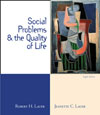 |  Social Problems and the Quality of Life, 8/e Robert H. Lauer,
U.S. International University
Jeanette C. Lauer,
U.S. International University
Population, Aging, and Urban Problems
Internet Exercises- For a global view of some population issues, access the CIA World Fact
Book Website. (http://www.odci.gov/cia/publications/factbook/index.html)
Select "Country Listing" and scroll through the alphabetically ordered
list of nations. Notice the kinds of information available when you click
on a specific country.
- Create a comparative table for Albania, Canada, Jamaica, Niger, Peru,
and Sri Lanka. Include the following data in your table: (1) The age structure
for age-groupings as given [0-14, 15-64, and 65 and over], (2) the infant
mortality rate, and (3) the average per capita income.
- What conclusions can you draw from your table?
- Does there seem to be a relationship between the age structure, for example,
and the infant mortality rate?
- What do you think that relationship might signify?
- People are living longer in a society that worships
youth, a society in which the media relentlessly categorize age as an evil
to be avoided, or at least to be hidden as long as possible. Access the
National Council on Aging Website. (http://www.ncoa.org)
Explore the site. Examine its programs and assess the frame of reference
of the NCOA. From their home page, click on "Press Room"; then
scroll down and in the section "About NCOA" click on the link
to "Facts About the Aging."
- Read about the size of the older population and briefly summarize what
you find.
- What is the gender ratio among the aging?
- How does that affect marriage patterns and the places that the aging tend
to reside?
|
|



 2002 McGraw-Hill Higher Education
2002 McGraw-Hill Higher Education